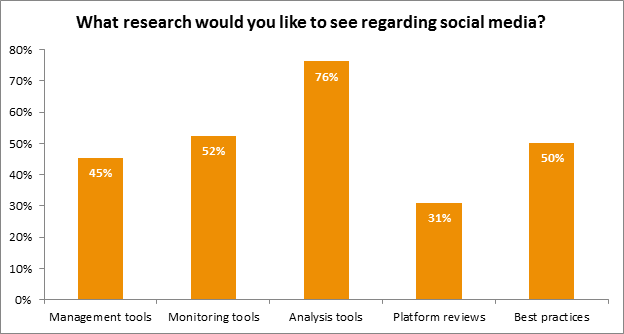Source: AMT Lab Reader Poll, 2014
As many arts marketers, social media gurus, and nonprofit professionals attest—including AMT Lab’s own Caroline Brent—the question for nonprofit arts organizations is no longer whether or not to use social media but rather how to use it most effectively. This shift is reflected by AMT Lab readers’ responses to our 2014 AMT Lab Reader Poll, where a whopping 76% of respondents indicated they would like to see additional research on social media analytics while only 31% indicated interest in research on social media platforms themselves. As CMU prepares to embark on the 2014-2015 school year, we present below a recap of recent articles that speak to the question of how to optimize social media efforts. We’ll keep digging into the question of analysis; in the meantime, brush up on tips for growing your art organization’s social side.
Source: Rob Cottingham, Noise to Signal
Management
For arts managers seeking to leverage the power of social media, a comprehensive social media policy is the place to begin. Elizabeth Quaglieri provides an introduction to creating a social media policy in “Playing by the Rules,” drawing on advice from Idealware’s workbook designed specifically for nonprofits.
With a sound organizational policy in place, arts managers next have to contend with managing multiple platforms simultaneously. For small arts organizations—where time, staffing, or other resources often fall short to effectively implement a social media plan—social media management software can be particularly valuable. Caroline Brent’s white paper Social Media Management Software: An Overview for Small Arts Organizations investigates a variety of products to address this challenge, while Haisong Li’s review of Buffer lends insight on another tool that can help.
Monitoring & Analytics
The nut we’re all trying to crack: What to do with all the data your social media platforms collect? How to know what’s going on out there in the nebulous world of social? Arts organizations large and small can avail themselves of monitoring and analytics tools available at a variety of price points. Christine Sajewski highlights three free tools to benchmark and monitor your online presence. For arts organizations able to invest financially in an analytics tool, Haisong Li reviews Brandwatch as a potential solution. And to understand how social media monitoring software works—and why to use it—Caroline Brent provides an explanation in her research update “Social Media Monitoring Software.”
Source: Christine Sajewski, "Free Tools for Benchmarking and Monitoring Your Online Presence"
Marketing
With your social media platforms up and running, how do savvy arts managers make the most of them? Rachael Wilkinson explains the value of visually based social media (rather than text-based) and provides three easy tips for nonprofit marketers. Guest blogger Erik Gensler, president of Capacity Interactive, weighs in with six ways arts organizations can improve their Facebook advertising, while Vivi outlines step-by-step instructions to identify and work with your organization’s top influencers. To fill the gap between email campaigns and social media marketing, check out Haisong Li’s product review of Attentive.ly.
Source: Geoff Livingston, JESS3
Audience Engagement
Last but not least is social media’s potential to boost engagement with your arts organization’s audiences. Much conversation is being had about tweet seats, including Deb Sherrer’s 3-part series on the subject; read all three articles here: Part 1, Part 2, Part 3. Rachael Wilkinson warns of potential legal implications in “The Peril of Tweet Seats” and later reports on the University Musical Society’s tweet seat initiative.
Source: Rikke Baggesen
And finally, Elizabeth Quaglieri looks at an alternate application of Twitter in her profile of HintMe, a mobile museum platform being used by a dozen Danish museums.
So take a breath, sit back, and grow your social! Be sure to let us know how it goes—and what new information would be most helpful for your efforts.






